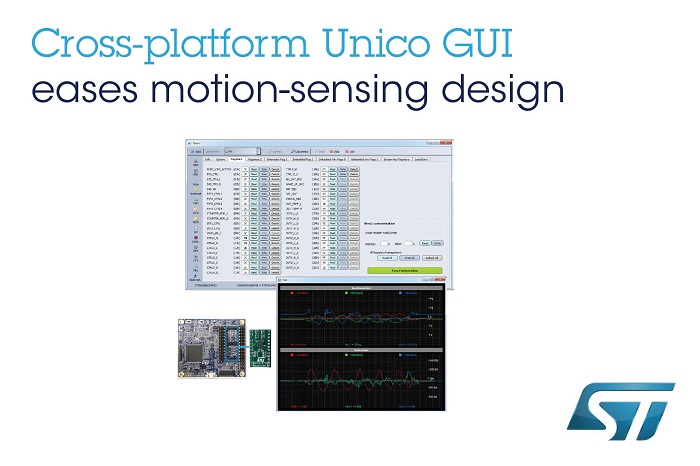By Carolyn Mathas, contributing writer
STMicroelectronics just unveiled the Unico GUI , a cross-platform graphical user interface (GUI) that simplifies the finite state machine (FSM) and machine-learning core (MLC) logic configuration of its latest inertial measurement units (IMUs). The Unico GUI runs on Windows , Linux , and Mac OS and interacts with ST’s MEMS sensor demonstration boards including accelerometers, gyroscopes, magnetometers, and environmental sensors supported by the STEVAL-MKI109V3 motherboard. (Also visit New motherboard makes MEMS products more accessible for more information. )
The recently announced LSM6DSO and LSM6DSOX six-axis modules are also supported by the Unico GUI. The LSM6DSO module contains logic for up to 16 independent state machines that generate a hardware interrupt activated by a specific motion pattern, while the LSM6DSOX module contains the logic to implement multiple-stage decision trees for machine-learning classification.

The STMicro Unico GUI software visualizes sensor output in both graphical and numeric formats, allowing users to save or manage a device’s data output.
Features of the Unico GUI include a complete software package for MEMS evaluation boards, programmable voltage power supply between 1.8 V to 3.6 V, sensors current consumption measurement, communication protocol SPI/I2 C selectable on the fly, and a device firmware upgrade application.
With the Unico GUI, gesture and motion-recognition algorithms directly run in the sensor via FSM logic for always-on use and low power consumption, while MLC implements machine-learning classifiers for real-time always-on motion and vibration pattern recognition. The GUI also easily combines the module’s accelerometer and gyroscope data with inputs from additional external sensors, such as a magnetometer, for even more sophisticated context-sensing capabilities.
When used in smartphones, wearables, and industrial devices, the FSM and MLC (as an embedded, low-power engine for gesture and motion recognition) allow user-interface functions and context-based applications to continue to operate while the main processor sleeps, which maximizes battery runtime.
Advertisement
Learn more about Electronic Products Magazine





